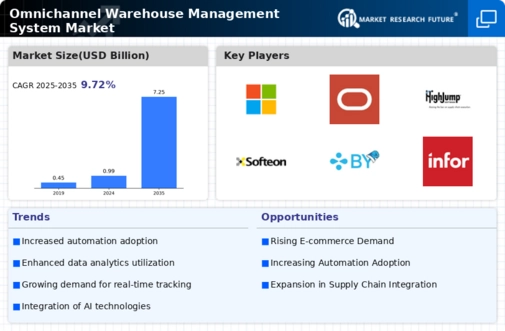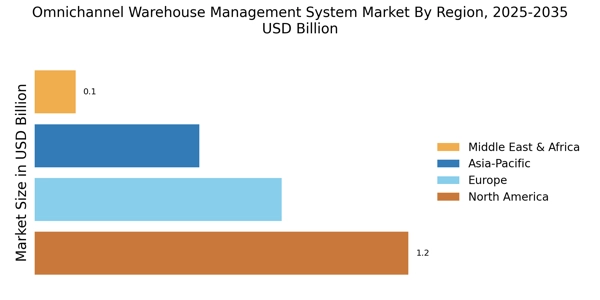Rising E-commerce Demand
The surge in e-commerce activities has catalyzed the growth of the Omnichannel Warehouse Management System Market. As consumers increasingly prefer online shopping, businesses are compelled to enhance their logistics and inventory management capabilities. This shift necessitates the adoption of sophisticated warehouse management systems that can seamlessly integrate various sales channels. According to recent data, e-commerce sales are projected to reach trillions of dollars, prompting retailers to invest in omnichannel solutions to meet customer expectations. The Omnichannel Warehouse Management System Market is thus experiencing heightened demand as companies strive to optimize their supply chains and improve order fulfillment efficiency.
Technological Advancements
The rapid advancement of technology plays a crucial role in shaping the Omnichannel Warehouse Management System Market. Innovations such as artificial intelligence, machine learning, and the Internet of Things are transforming warehouse operations. These technologies enable real-time data analytics, predictive inventory management, and automated processes, which enhance overall efficiency. As businesses increasingly adopt these technologies, the demand for sophisticated warehouse management systems is expected to rise. Reports suggest that the integration of such technologies can lead to a reduction in operational costs by up to 20%, further driving the growth of the Omnichannel Warehouse Management System Market.
Focus on Inventory Management
Effective inventory management is becoming increasingly critical in the Omnichannel Warehouse Management System Market. As businesses expand their sales channels, the complexity of managing inventory across multiple platforms grows. Companies are recognizing the need for robust warehouse management systems that provide real-time inventory tracking and analytics. This focus on inventory management is driven by the desire to minimize stockouts and overstock situations, which can adversely affect profitability. Recent studies indicate that organizations with effective inventory management practices can achieve a significant reduction in carrying costs. Thus, the emphasis on inventory management is a key driver of growth in the Omnichannel Warehouse Management System Market.
Need for Operational Efficiency
In an era where operational efficiency is paramount, the Omnichannel Warehouse Management System Market is witnessing significant growth. Companies are increasingly recognizing the importance of streamlining their warehouse operations to reduce costs and enhance productivity. By implementing advanced warehouse management systems, businesses can achieve better inventory visibility, minimize errors, and optimize labor utilization. Data indicates that organizations utilizing these systems can improve their order processing times by up to 30%. This drive for efficiency is a key factor propelling the adoption of omnichannel solutions, as firms seek to remain competitive in a rapidly evolving marketplace.
Consumer Expectations for Fast Delivery
The evolving consumer expectations for rapid delivery services are significantly influencing the Omnichannel Warehouse Management System Market. As customers demand quicker shipping options, retailers are compelled to adapt their logistics strategies accordingly. This trend necessitates the implementation of efficient warehouse management systems that can facilitate faster order processing and fulfillment. Data shows that a substantial percentage of consumers are willing to pay extra for expedited shipping, highlighting the importance of meeting these expectations. Consequently, businesses are increasingly investing in omnichannel solutions to enhance their delivery capabilities and maintain customer satisfaction in a competitive landscape.


















Leave a Comment